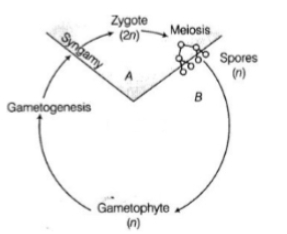The life cycle is not haplo-diplontic in:
1. Bryophytes
2. Pteridophytes
3. Polysiphonia
4. Fucus
Both bryophytes and pteridophytes:
1. are vascular cryptogams
2. have a dominant sporophyte
3. reproduce only sexually
4. are haplo-diplontic
The life cycle pattern shown in the given diagram is not seen in:

1. Chlamydomanas
2. Spirogyra
3. Volvox
4. Ectocarpus
Zygotic meiosis is characteristic of
(1) Marchantia
(2) Fucus
(3) Funaria
(4) Chlamydomonas
Double fertilisation is exhibited by
(1) gymnosperms
(2) algae
(3) fungi
(4) angiosperms
Life cycle of Ectocarpus and Fucus respectively are
(1) Haplontic, Diplontic
(2) Diplontic, Haplodiplontic
(3) Haplodiplontic, Diplontic
(4) Haplodiplontic, Haplontic
The world's tallest (angiosperm) flowering tree is
(1) Sequoia
(2) Eucalyptus
(3) Pinus
(4) Cedrus
Occurrence of triploid (3n) primary endosperm nucleus is a characteristic feature of
(1) Algae
(2) Gymnosperms
(3) Angiosperms
(4) Bryophytes
The diploid sporphyte is represented by a dominant, independent, photoshynthetic, vascular plant body. It alternates with multicellular, saprophytic/autotrophic, independent but short-lived haploid gametophyte. This type of pattern is exhibited by
1. Bryophytes (Sphagnum, Polytrichum).
2.Pteridophytes (Selaginella, Lycopodium).
3. Most of the algal genera (Fucus, Chara, Polysiphonia).
4. Seed plants (gymnosperms and antiosperms).
The type of life-cycle in which there is no free-living sporophytes and the dominant, photosynthetic phase in such plants is the free-living gametophyte. We are talking about
1.Haplontic life cycle shown in Volvox and some species of Chlamydomonas.
2.Diplontic life cycle as shown in seed-bearing plants.
3.Haplo-diplontic life cycle as shown in bryophytes and pteridophytes.
<p">4.Haplo-diplontic life cycle as shown in Kelps.






